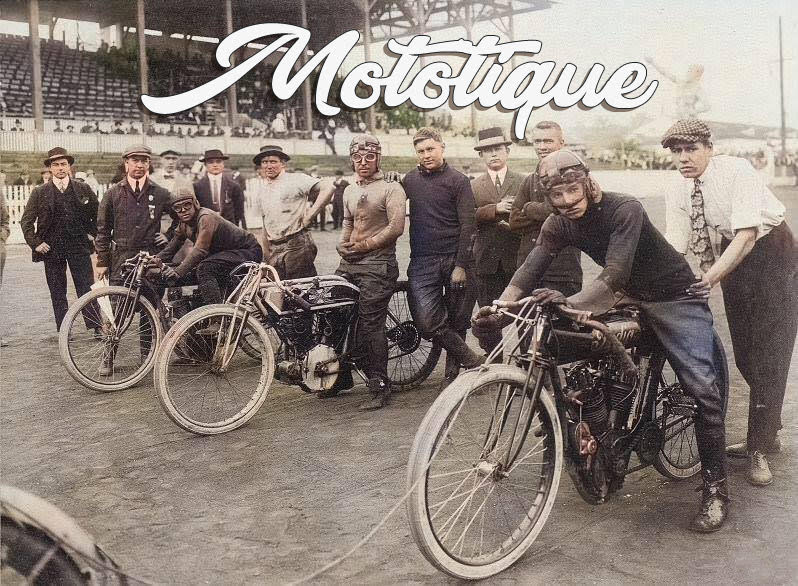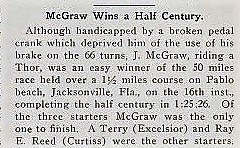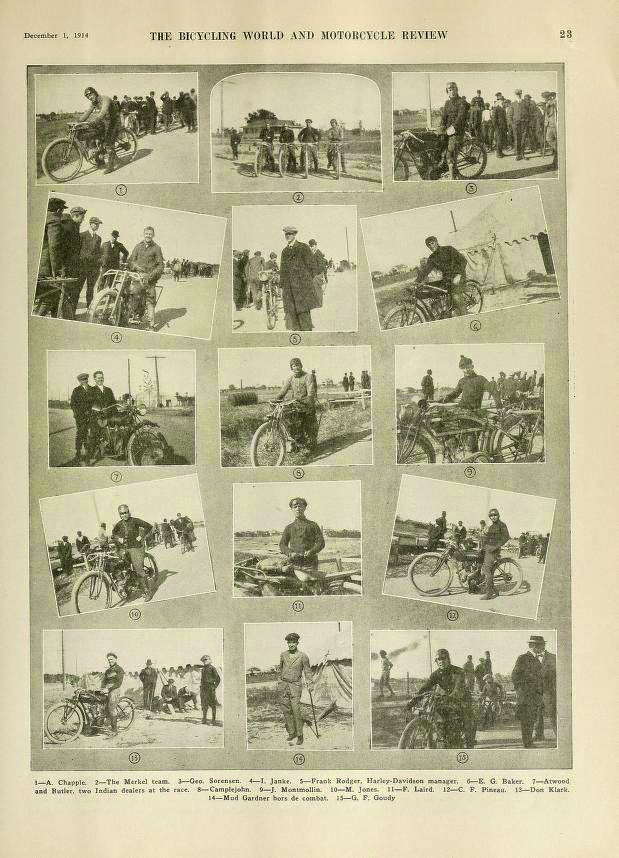June 13, 2013
Updated - June 12, 2015
By: David L. Morrill
@Deadly Dave's Blog
@Deadly Dave's Blog
Sylacauga, Alabama
 |
| Atlanta's Henry Hammond Springs -1921 Don Emde Collection |
The idea for this article came to me, while I was researching the death of early Birmingham, Alabama racer Gene Walker. The June 1924 issue of Motorcycling & Bicycling had an article on Walker's death, but also included a photograph of the dedication of a memorial to Atlanta racer Hammond Springs on the second anniversary of his death.
As I looked around for information on Springs' racing career, I found there was little information available. Springs rose from a local Atlanta racer to ride an Indian factory prepared racer in the most prestigious national race of that time. At the time, he was the youngest professional racer in the country. While much of Hammond Springs' story has been lost to time, it is time to share what remains.
Henry Hammond Springs was born in Augusta, Georgia in 1902. Tragedy came early to the Springs family. On December 26,1909, Hammond's father, Augusta Fire Fighter Edward Springs, was killed responding to a fire. Edward Springs was driving a steamer fire truck to the scene of a fire, when he was pulled from the driver's seat, and run over by the wheels. Several years later Hammond's widowed mother Mary remarried, and the family moved to Atlanta.
Growing up in Atlanta, which was the southern capital of motorcycle racing, Hammond Springs was drawn to motorcycle racing. Racing a Harley-Davidson, Springs began honing his racing skills at Atlanta's Lakewood Speedway. The one-mile oval dirt track, which was located south of downtown Atlanta, held its first motorcycle race in front of a crowd of twenty-three thousand spectators on July 4, 1917.
Lakewood Speedway
Atlanta, GA.
Professional motorcycle racing had been curtailed throughout the country during America's involvement in World War 1. Some local racing continued during this period, which allowed amateur racers like Hammond Springs, to compete with more experienced professional racers. Springs first mention in the press was as an entry for the Lakewood Races held on July 4, 1918.
He is not mentioned in the results. There were no motorcycle races held at Lakewood Speedway on Labor Day. The event sponsors dropped motorcycle racing in favor of Automobile races. It was probably due to the death of Atlanta rider Ed Wilcox on the first lap of the 1917 Labor Day race at Lakewood.
When professional racing returned to Atlanta in 1919, seventeen-year-old Hammond Springs had already made a name for himself at Lakewood racing his eight valve Harley-Davidson.
In June 1919, Springs had his first serious brush with the danger involved in racing. While chasing Nemo Lancaster at Lakewood, Springs struck the rear tire of Lancaster's machine. Both riders were violently thrown from their machines, with Springs landing on his head. The spectators, who saw the crash, feared both riders had been killed. Both Springs and Lancaster required medical attention, but later returned to the track, to watch the final races. They were a bit banged up, but not seriously injured. |
| Atlanta Constitution - July 4, 1918 |
He is not mentioned in the results. There were no motorcycle races held at Lakewood Speedway on Labor Day. The event sponsors dropped motorcycle racing in favor of Automobile races. It was probably due to the death of Atlanta rider Ed Wilcox on the first lap of the 1917 Labor Day race at Lakewood.
When professional racing returned to Atlanta in 1919, seventeen-year-old Hammond Springs had already made a name for himself at Lakewood racing his eight valve Harley-Davidson.
 |
| Atlanta Constitution - May 29, 1919 |
 |
| Atlanta Constitution - June 1919 Furman Family Collection |
The caption for this photo collage from the Atlanta Constitution states:
"At the top is a scene from the northwest turn at Lakewood snapped a few minutes before the accident occurred. At the left below is Eugene Walker who regained his title as Southern Dirt Track Champion. At the right below are the two principles in the accident. Nemo Lancaster has his right foot bandaged, and Hammond Springs has a cracked dome as a result of the smash-up. Neither was seriously injured as both were back on the track to witness the ten-mile championship."
On July 4, 1919, Springs finished third in the one-mile trial, less than a second behind Indian riders Nemo Lancaster and Tex Richards. Rain plagued the later races, and Springs was unable to keep up his earlier pace on the wet track.
 In August 1919, Hammond Springs was involved in one of the more unusual stories of early Atlanta motorcycle racing. Each year, small group of black racers competed in an outlaw race at Lakewood Speedway billed as the Grand Colored Motorcycle Championship Race. The event drew large crowds from Atlanta's black community.
In August 1919, Hammond Springs was involved in one of the more unusual stories of early Atlanta motorcycle racing. Each year, small group of black racers competed in an outlaw race at Lakewood Speedway billed as the Grand Colored Motorcycle Championship Race. The event drew large crowds from Atlanta's black community. While the Atlanta Indian and Harley-Davidson dealers were not directly involved in the race, several of the racers worked for them, and they often provided back door support. This may not have been purely philanthropic on the dealer's part, as large side bets were often placed between them on the race outcome.
Hammond Springs had recently switched to riding for the Atlanta Indian dealer Harry Glenn, and his mechanic was black racer Hal "Demon" Wade. After Wade complained to Springs that his tired 1912 Indian racer was not up to the challenge, Springs took matters into his own hands. Without permission, Springs and Wade snuck in the Indian shop on the night before the race and removed the new big valve racing engine from Springs' racer. Then they installed it in Wade's 1912 racer.
Atlanta's Hal "Demon" Wade - 1919
The competitive engine allowed Wade to easily win the final race. The story came out in an article in Motorcycling & Bicycling, and in Jim Crow Atlanta, it could have certainly put an end Springs' racing career. Springs' sponsor won a tidy side bet on the race outcome with the local Harley-Davidson dealer, and all was forgiven.
With Hammond Springs success in the July 4th Atlanta races, Harry Glenn was anxious for his young rider to begin professional competition. Glenn convinced Springs' Mom to allow the 17-year-old to enter the Labor Day races at Lakewood.
The Labor Day motorcycle races returned to Lakewood Speedway in 1919. They drew large crowds and a big purse, which attracted the best riders in the South. Hammond Springs race ended with a blown engine on the first lap of the race. Rumors at the time had Hammond springs going to the Harley-Davidson team for the 1920 season.
 |
| Motorcycle Illustrated - September 18, 1919. |
Atlanta Constitution
July 6, 1920
 |
| Motorcycle and Bicycle Illustrated - July 8, 1920 |
 |
| Motorcycle and Bicycle Illustrated - September 1, 1921 |
 |
| Atlanta Constitution - June 12, 1921 |
Harley-Davidson dispatched a large team of riders, with Ralph Hepburn and Otto Walker setting the second and third fastest laps. As the race started, pole sitter Shrimp Burns, pulled out with mechanical problems. The heat, and the length of the race took a toll on several of the other Indian riders, who slowed with mechanical problems. The race was won Harley-Davidson's Otto Walker. The only bright spot for Indian, was Johnny Seymour's second place finish. The remaining top finishers were all Harley-Davidson mounted.
After the Dodge City race, Hammond Springs traveled to the Indian factory in Springfield, Massachusetts. During that visit, he was photographed on his Dodge City racer on the factories roof.
On August 15, 1921, Hammond Springs won the 10 Mile Professional Race on the one-mile dirt track at Pottstown, Pennsylvania. Springs edged out Harley-Davidson's star rider, Jim Davis, by just two feet at the finish. Davis had won the 5 Mile Professional Race, and set a new track record earlier that day, with Springs finishing fourth.
On May 17, 1922, an article appeared in the Atlanta Constitution on local riders Nemo Lancaster and Hammond Springs entering the upcoming race at the Lakewood Speedway. In describing Springs, the article stated:
Atlanta Constitution
May 17, 1922
 |
Motorcycle and Bicycle Illustrated - May 25, 1922 |
Atlanta Constitution
May 21, 1922
But, as fate often has it in the racing game, Springs' greatest triumph was followed only nine days later by tragedy.On May 30, 1922, Hammond Springs traveled to the half mile dirt track at Springbrook Park in South Bend, Indiana. Springs was leading the last race of the day, with Dayton, Ohio rider Eddie Brinch close behind. They collided throwing both riders from their machines. Brinch sustained a broken collarbone, but Hammond Springs died of his injuries that evening in a South Bend Hospital.
This article from Wichita Daily Eagle contains the last known photograph of Hammond Springs racing. At the time the article was written, it was boot known he had died from injuries.
 |
| Wichita, KA. Daily Eagle - May 30, 1922 |
 |
| Atlanta Constitution - May 1922 |
 |
| Wichita, KA. Beacon - May 31, 1922 |
The coroner's inquest found the death was a racing accident and cleared both riders of responsibility for the fatal accident. Springs was nineteen, when he died. Hammond Springs was returned to Atlanta and buried at West View Cemetery.
On the day of his funeral, Springs received a motorcycle escort to the cemetery from both the Atlanta Police Department and the Atlanta Motorcycle Club. Atlanta motorcycling notables Harry Glenn, Hal Gilbert, Nemo Lancaster, Tex Richards, and Charlie Hages were pallbearers at his funeral. Atlanta's motorcycle shops were closed the day of his funeral, as an act of respect for Springs family.
Hammond Spring's Funeral Notice
Atlanta Constitution
June 3, 1922
Motorcycle and Bicycle Illustrated
June 1924
Bertha Avery Hood Collection - 2011
In the December 1922 Motorcycle and Bicycle Illustrated reported that Hammond's brother, Clarence Springs, had taken over long time Atlanta Harley-Davidson dealer, Gus Castle's, Atlanta business interests.
 |
| Motorcycle and Bicycle Illustrated - December 28, 1922 |
Author's Note:
Special thanks to Don Emde and Mike Bell for their contributions to this story.
Sources:
Atlanta Constitution
Bertha Avery Hood Collection
Don Emde Collection
Find A Grave.com
Furman Family Collection
Mike Bell Collection
Motorcycle and Bicycle Illustrated
Stephen Wright - American Racers 1900-1940
Wichita, KA. Beacon
Wichita, KA. Daily Eagle
Wikipedia.org
Sources:
Atlanta Constitution
Bertha Avery Hood Collection
Don Emde Collection
Find A Grave.com
Furman Family Collection
Mike Bell Collection
Motorcycle and Bicycle Illustrated
Stephen Wright - American Racers 1900-1940
Wichita, KA. Beacon
Wichita, KA. Daily Eagle
Wikipedia.org





.jpg)







.jpg)





































